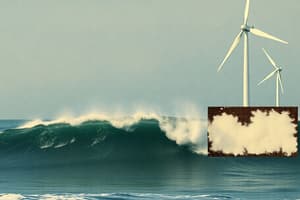Podcast
Questions and Answers
What is the affiliation of Aboozar Tabatabai?
What is the affiliation of Aboozar Tabatabai?
- University of California, Berkeley
- University of Miami
- Florida State University
- Rutgers, the State University of New Jersey (correct)
In what field does Aboozar Tabatabai work?
In what field does Aboozar Tabatabai work?
- Environmental Policy
- Marine Biology
- Marine and Coastal Sciences (correct)
- Ocean Engineering
When was the referenced work by Aboozar Tabatabai published?
When was the referenced work by Aboozar Tabatabai published?
- January 2010
- November 2010 (correct)
- August 2010
- May 2011
What is the primary geographical focus of Aboozar Tabatabai's research?
What is the primary geographical focus of Aboozar Tabatabai's research?
Which university's institute does Aboozar Tabatabai belong to?
Which university's institute does Aboozar Tabatabai belong to?
What is the primary focus of the class presentation mentioned?
What is the primary focus of the class presentation mentioned?
Who presented the introduction to ocean renewable energies?
Who presented the introduction to ocean renewable energies?
Which aspect is NOT directly referenced in the context of the presentation?
Which aspect is NOT directly referenced in the context of the presentation?
What is implied by the title of the class presentation?
What is implied by the title of the class presentation?
The term 'ocean renewable energies' primarily refers to which type of energy generation?
The term 'ocean renewable energies' primarily refers to which type of energy generation?
Flashcards
Ocean Renewable Energies
Ocean Renewable Energies
Energy sources derived from the ocean, like waves, tides, and currents.
Physical Oceanography
Physical Oceanography
The study of the physical aspects of the ocean.
Class Presentation
Class Presentation
A formal presentation given in a classroom setting.
Introduction
Introduction
Signup and view all the flashcards
Presented by S.
Presented by S.
Signup and view all the flashcards
Aboozar Tabatabai
Aboozar Tabatabai
Signup and view all the flashcards
Rutgers University
Rutgers University
Signup and view all the flashcards
Institute of Marine and Coastal Sciences
Institute of Marine and Coastal Sciences
Signup and view all the flashcards
November 2010
November 2010
Signup and view all the flashcards
Why Ocean?
Why Ocean?
Signup and view all the flashcards
Study Notes
Ocean Renewable Energies
- The ocean is the largest solar collector, providing a vast amount of kinetic and thermal energy.
- This energy source is clean, predictable, sustainable, and strategic.
- Changes in salinity, thermal gradients, tidal levels, and currents, or ocean waves can be used to generate electricity.
- Over 100 known ocean energy technologies exist, with global potential equal to present worldwide electricity production.
Types of Ocean Energy
- Tides: Potential energy from tides can be harnessed using barriers across estuaries.
- Tidal Currents: Kinetic energy from tidal currents is harnessed using modular devices, currently under development and undergoing sea trials.
- Waves: Kinetic and potential energy of waves can be harnessed using modular technologies. Wave arrival times can be predictable or more variable.
- Salinity Gradients: Energy from mixing fresh and salt water can be harnessed using pressure-retarded reverse osmosis.
- Thermal Gradients: Energy from temperature differences between surface and deep ocean water can be harnessed using Ocean Thermal Energy Conversion (OTEC) processes.
Global Ocean Energy Resources
- Theoretical Resources (TWh/year): Tides (300+), ocean waves (8,000-80,000), tidal currents (800+), temperature gradients (10,000), and salinity gradients (2,000).
- Estimated Global Electricity Production (TWh/year): Tidal (0.3K), Tidal Current (0.8K), Ocean Waves (8K-80K), Salinity Gradient (2K), and Thermal Energy (10K)
- Significant differences between theoretical resource potential and estimated production.
Specific Technologies and Examples
- Tidal Energy:
- The Rance estuary near St. Malo, France, has the world's largest tidal power plant.
- The Sihwa, South Korea, is the world's largest tidal power plant with a total power of 260 MW and an annual power generation of 543 GWh.
- Wave Energy: Different devices like oscillating water columns (OWCs) or various types of floating or submerged devices exist.
- Salinity Gradients:
- Statkraft, Norway, has installed the world's first osmotic plant (generating 4 kW).
- Ocean Thermal Energy Conversion (OTEC):
- A facility exists at Keahole Point, Hawaii.
- Ocean Thermal Energy Conversion (OTEC): demonstration of 1 MW device at Saga University, Japan, and a 30 kW OTEC system.
Studying That Suits You
Use AI to generate personalized quizzes and flashcards to suit your learning preferences.




